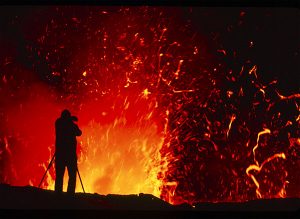
A new study from the active volcano Kīlauea, which is on the big island of Hawaii, reports that people — especially children — with asthma are at greater risk of having serious asthma attacks if they live in a community with high levels of the volcanic gas sulfur dioxide (SO2) than if they live upwind of the volcano.
Volcanoes can emit SO2 and other airborne chemicals while erupting, and human sources of SO2, like coal plants, are reputed triggers of asthma attacks. Nurse epidemiologist Bernadette Mae Longo, from the University of Nevada, Reno, began to question whether volcanic sulfurous air pollution, known as “vog,” was linked to human health after having conversations with local health care professions and conducting door-to-door surveys near Kīlauea.
“As a nurse, it touched my heart, because I knew as I read a medical record that this was a real person struggling. Or maybe this was a family with a baby or child that had asthma, and it is very frightening when an asthma attack occurs,” says Longo, who will speak on the subject on Tuesday, 27 Sept., at the meeting of the Geological Society of America in Denver, Colorado. “The overriding question was: ‘is all the volcanic air pollution making people sick?’ ”
SO2 is considered a “non-threshold” gas, meaning that the amount of SO2 needed to trigger an asthma attack varies person to person. People without asthma or other respiratory illnesses can breath in a larger amount of SO2 before experiencing breathing problems.
After confirming that communities downwind of Kīlauea were being exposed to volcanic SO2, Longo initiated a seven-year study that ran from 2004 to 2010. She monitored atmospheric SO2 levels and documented the number of people who visited either emergency rooms or local clinics in need of immediate medical treatment for an asthma attack. She compared communities living downwind of the volcano, and thereby exposed to SO2 emissions, to communities upwind of the volcano. Longo ended up recording information from more than 1,000 visits from patients, who ranged in age from three months old to more than 89 years.
The risk of an asthmatic experiencing a serious asthma attack was three times higher for people living downwind of the volcano compared to populations living upwind of the volcano, once the data was corrected for age and gender. When she considered age, Longo found that the children downwind of Kīlauea were at much higher risk of an attack than the unexposed children.
Specifically, Longo saw that the risk of asthma attacks increased with in-town SO2 concentrations and not the amount of emissions gushing from the volcano. Furthermore, communities closer to the vents had a higher risk of asthma attacks compared to communities farther downwind.
At the beginning of the study, the East Rift Zone of Kīlauea was continuously erupting on a small scale, but the Halemaumau Crater of Kīlauea explosively erupted in 2008, causing SO2 emissions to skyrocket. Even now, downwind communities still exceed EPA recommendations for SO2 exposure a few times during the week, according to Longo.
“It allowed for a natural experiment of low vog exposure and high vog exposure,” says Longo. “We found that there was already significant risk before the summit eruption, but the magnitude of risk increased after the eruption.”
Overall, vog exposure appears to be hazardous to the health of those with asthma, because every asthma attack can further damage a patient’s lungs. Longo suggests geologists, public health care workers, and clinicians can work collaboratively to write guidelines that would allow clinicians to provide the best evidence-based, culturally sensitive care for the vulnerable populations living on volcanoes. In addition, Longo says scientists need to continue researching the effects of vog pollution on human health, not only on SO2, but also on the other gases and particulates in vog.
“We can’t shut the volcano off, and if we don’t document that there is this problem, there may not be the initiative to do something to try and help these populations,” says Longo.
Note: The above post is reprinted from materials provided by Geological Society of America.










